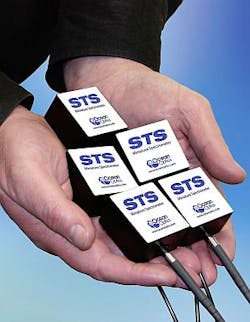Ocean Optics miniature spectrometers suit LED characterization
The STS Microspectrometer family includes 350–800 nm and 650–1100 nm versions, both of which feature a 1024-element CMOS detector in a crossed Czerny Turner optical bench. The spectrometers provide full spectral analysis with low stray light, high signal to noise (>1500:1) and typical optical resolution of ~1.5 nm at FWHM. Ideal for embedding into OEM devices, applications include characterization of LEDs and absorbance/transmittance of various samples.
Ocean Optics
Dunedin, FL
[email protected]
More Products
-----
PRESS RELEASE
STS Microspectrometer Provides Big Performance in a Small Footprint
Ocean Optics’ tiny CMOS-based spectrometer is ideal for OEM applications
Dunedin, Florida (February 15, 2011) – Ocean Optics (www.oceanoptics.com) has introduced a family of low-cost, high-performance CMOS detector-based spectrometers that are ideal for embedding into OEM devices. Despite its tiny footprint – less than two inches square (40 mm x 42 mm) and one inch (24 mm) high – STS provides performance comparable to larger systems: full spectral analysis with low stray light, high signal to noise (>1500:1) and typical optical resolution of ~1.5 nm (FWHM). STS is a great option for a range of VIS-NIR applications including characterization of LEDs and absorbance/transmittance of various samples and is ideal for OEM applications where one or more wavelengths are being monitored and highly reproducible results are necessary.
The STS Microspectrometer is available in standard models with 350-800 nm and 650-1100 nm wavelength coverage. Customization of wavelength range, entrance aperture and other optical bench accessories is available for high-volume and OEM customers. Also, unlike other microspectrometers, STS has a built-in shutter for making dark measurements. Operating software is priced separately and provides a full range of spectroscopic functions as well as control of the shutter. Packages for developing customized software for STS are also available.
At the heart of the STS is a 1024-element CMOS detector in a crossed Czerny Turner optical bench. The bench is distinguished by specially designed collimating and focusing mirrors and a 600 lines/mm groove density grating. Its optical design and advanced CMOS detector elevate STS to performance levels comparable to larger and more expensive spectrometers. For example, STS has 14-bit A/D resolution and has low power consumption of just 0.75 W. Also, with customization of the entrance aperture, optical resolution less than 1.0 nm (FWHM) is possible. This makes STS an attractive option for a wide range of applications.
To learn more about STS, contact Ocean Optics’ dedicated engineering team www.OceanOEM.com, [email protected], or +1 727-733-2447.
Headquartered in Dunedin, Fla., Ocean Optics is a leading supplier of solutions for optical sensing – fundamental methods of measuring and interpreting the interaction of light with matter. With locations in Asia and Europe, the company has sold more than 150,000 spectrometers worldwide since 1992. Ocean Optics’ extensive line of complementary technologies includes chemical sensors, analytical instrumentation, optical fibers, metrology products and optics. The company is a subsidiary of Halma p.l.c., an international market leader in safety, health and sensor technology.
-----
Follow us on Twitter
Subscribe now to Laser Focus World magazine; it's free!
